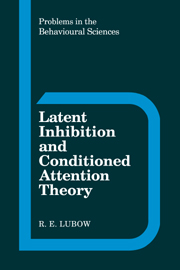Book contents
- Frontmatter
- Contents
- Preface
- 1 Introduction
- 2 Latent inhibition testing procedures
- 3 Variables affecting latent inhibition
- 4 Organismic variables affecting latent inhibition
- 5 Associative learning tests of the effects of stimulus preexposure in children and adults
- 6 Neural substrates of latent inhibition
- 7 Theories and explanations of latent inhibition in animals
- 8 Conditioned attention theory of latent inhibition
- 9 Conditioned attention theory as applied to latent inhibition in humans
- 10 Some applications of conditioned attention theory: learned helplessness and schizophrenia
- Notes
- References
- Author index
- Subject index
9 - Conditioned attention theory as applied to latent inhibition in humans
Published online by Cambridge University Press: 13 October 2009
- Frontmatter
- Contents
- Preface
- 1 Introduction
- 2 Latent inhibition testing procedures
- 3 Variables affecting latent inhibition
- 4 Organismic variables affecting latent inhibition
- 5 Associative learning tests of the effects of stimulus preexposure in children and adults
- 6 Neural substrates of latent inhibition
- 7 Theories and explanations of latent inhibition in animals
- 8 Conditioned attention theory of latent inhibition
- 9 Conditioned attention theory as applied to latent inhibition in humans
- 10 Some applications of conditioned attention theory: learned helplessness and schizophrenia
- Notes
- References
- Author index
- Subject index
Summary
In the preceding chapter we developed and applied CAT to the data from latent inhibition studies with animals, but we ignored the data from experiments with human subjects. It will be recalled that these human studies present a pattern of results not entirely consistent with that obtained from lower organisms. To review, the major findings, presented in chapter 5, are as follows:
There are standard stimulus preexposure procedures that will produce latent inhibition in young children, but not in older children or adults.
If these same procedures are coupled with a masking task, then latent inhibition can be produced in older children and adults.
Nevertheless, there are some procedures (i.e., electrodermal conditioning, conditioned tasted aversion, and Ivanov-Smolensky conditioning) that may not require masking for the production of latent inhibition.
The last point will be dismissed, perhaps somewhat cavalierly, because of the difficulty in separating the unconditioned response to the CS (orienting or otherwise) from the conditioned response to the CS in the test phase. As a result, one cannot determine whether stimulus preexposure produces an artifactual reduction in the conditioned response or a reduction in the associability of the CS. This, it will be recalled, is similar to the problem encountered in a number of animal conditioning paradigms. In addition, these studies with humans may have included unplanned masking procedures – either by the very nature of the procedure or by instruction.
Let us now consider the effects of age and masking on latent inhibition in humans.
- Type
- Chapter
- Information
- Latent Inhibition and Conditioned Attention Theory , pp. 218 - 238Publisher: Cambridge University PressPrint publication year: 1989



